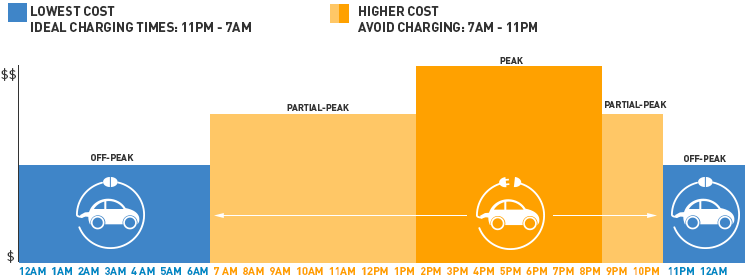We have had the fortune of helping more than 50 electric vehicle owners go solar. As shared in prior posts, fueling your car with solar electricity is the least expensive form of (automotive) transport: Your amortized cost to generate solar electricity is ~8 cents per kWh, and you yield about four miles per kWh of electricity. Trite but true: Driving on sunshine makes sense.
Better yet, when you enjoy an electric vehicle you can employ PG&E’s “EV” rate schedule. This time-of-use rate program incents EV drivers to charge their car (and shift other electricity demand) to “off-peak” hours, namely 11 pm to 7 am, Monday through Friday, and all weekend/holiday hours, sans 3-7 pm.
Here are PG&E’s “EV” rates per kWh:
Peak (2-9 pm, M-F): $0.33 (winter); $0.48 (summer)
Part Peak (7am-2pm; 9-11pm M-F): $0.20 (winter); $0.26 (summer)
Off Peak (11pm-7am M-F; weekends/holidays all hours except 3-7pm): $0.13
When your solar panels make more energy than your home uses, you are credited by PG&E via their net-metering program. Hence, the greater the delta (solar generation less household consumption) during “peak” periods, your monetary credits are amplified.
Generally, Repower homeowners who enroll in PG&E’s EV rate schedule only generate ~80% of the electricity they use to cover 100% of their electricity costs. This is simply due to the time-of-use rate schedule and the advantage of buying electricity at a low rate and getting credited at nearly 4x. Very cool.
With apologies for the bevy of metrics, let’s review an example. Below is the electricity use for a fairly standard Davis homeowner who charges their electric vehicle 12,000 miles per year at home.
Pre-solar electricity use and costs (on PG&E’s “E-1” program):
We then sized and modeled a solar system to eliminate the homeowner’s electricity bill: A 4.8 kW, 15-panel system installed at 270-degree azimuth (due west), no shading. The solar panels are projected to generate 6,493 kWh in year one, thus covering 70% of the homeowner’s electricity use.
If the homeowner did not own an electric vehicle, they would (upon going solar) enroll in PG&E’s “TOU-A” rate schedule. Like the EV rate, TOU-A values electricity based on demand (“peak” period is 3-8 pm), but there’s little difference between peak and off-peak periods.
Solar economics under the default E-TOU (A) rate schedule:
The homeowner’s year-end, true-up cost would be $645 — the solar system is too small. This is not bad, but …
… under the EV rate schedule, the homeowner generates significant time-of-generation credits/leverage. Their year-end bill would be $108.
Simple but lucrative: The homeowner will save an additional $500 per year through the EV rate schedule. Contact us today with questions and/or if you’d like a free solar assessment.









